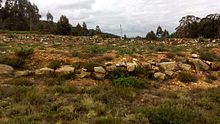Henge of Roda
The Henge of Roda (also known as A Roda) is a megalithic structure in the village of Roda, which the municipality of Barreiros in the province of Lugo in Galicia in Spain belongs. The henge is the first structure of its kind to be discovered and studied in the Iberian Peninsula .
The Henge (also henge monument ) was discovered in 2006 when preparatory work began on the construction of the Cantabrian A8 motorway between Barreiros and Reinante. Although Roda was known to have an archaeological site, it was believed to be a Castro. The archaeologists found that the pottery predated the Castro culture and the structure was too small to be a Castro. After the discovery, the route of the highway was changed and the henge was preserved on a property owned by the Ministry of Development. The building is now threatened by vegetation and erosion.
The remains of the Henges are in a plain at the foot of the mountain from which the area is controlled. It is a lithic circle about 50 meters in diameter that was built about 3700 years ago. It consists of an outer trench three to four meters wide. The circle is formed by two walls, between which earth has deposited. Next to the entrance is a stone that could be one of the menhirs that formed the entrance.
A similar formation was found in the municipality of Jove between San Cibrao and Celeiro. Another henge was found in Coeses in the municipality of Lugo (all in the province of Lugo) that has not yet been investigated.
Web links
- Isabel García Fernández: Os turistas sorpréndense ao ver esmorecer entre as silvas o Stonehenge galego 2018
Coordinates: 43 ° 32 '21.8 " N , 7 ° 10' 9.1" W.
